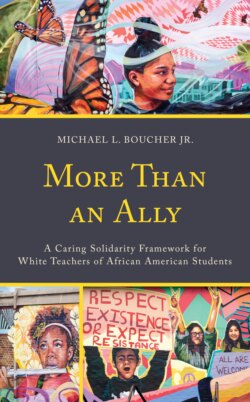Читать книгу More Than an Ally - Michael L. Boucher Jr. - Страница 15
На сайте Литреса книга снята с продажи.
Is the New Generation of Teachers the Same as the Old Generation?
ОглавлениеScholars have noted that White teacher candidates wrap deeply held racism in the language of care, believing that students of color do not value education and need to be motivated to learn with external reward systems like prizes, candy, or money. Often these preconceived deficit notions range from a clinical model of pathology, to wholesale condemnation of students’ culture, to an appeal that students should learn whiteness as a way to success (Osei-Kofi, 2005; Payne, 2013; Valencia, 2010). When candidates then go into the field, these stereotypes are often reinforced through teacher talk, an incomplete understanding of what they are seeing in classrooms, and a lack of awareness of their own biases (Sleeter, 2001b).
The cycle is perpetuated from candidacy to teaching to mentoring, and even as teachers join the professorate in schools of education, many still cling to their deficit models and seek to help candidates get “good placements,” meaning in wealthy White schools in the suburbs, and do not ask the larger questions about oppressive structures (see Mervosh, 2019).
As Valencia (2010) clarified, “deficit thinking typically offers a description of behavior in pathological or dysfunctional ways—referring to deficits, deficiencies, limitations, or shortcomings in individuals, families, and cultures” (p. 14). These models are not only the default for many teachers and teacher candidates, but they also blame students for a lack of success in the classroom (Boucher & Helfenbein, 2015; Gorski, 2006; Osei-Kofi, 2005).
According to Eslinger (2013), teachers fall victim to a savior mentality and a White supremacist belief structure that must be quelled in order to create a culturally responsive classroom. While teachers come to the profession as caring individuals, their models of care are often missing the aspects needed by Black students, that of solidarity with them, and deep knowledge of who students are—culturally, racially, and individually.
Teachers live in the intersection of theory, practice, societal forces, and economic realities. The data are clear that many White teachers see students as a bundle of deficits or as a threat to the learning environment. Britzman (2003) explained that teachers come to the profession with “chronologies” negotiated through their own classroom lives both as students and as teachers. When combined with their frames around “power, knowledge, dependency, and negotiation,” teachers negotiate their own socializations depending on their many interactions with culture and identity. If White teachers have not interrogated their own position as White people, they carry frames of White normality and supremacy into the classroom.
Britzman rejected the notion that there is one monolithic culture of teachers, stating, “Within any given culture, there exists a multiplicity of realities—both given and possible—that form competing ideologies, discourses, and the discursive practices that are made available to them” (p. 70). The ability to transcend racial divisions is not embedded in the potential teacher as an innate talent. Instead, teachers develop the required skills in a process that can take years depending on their understandings and experiences.
Because of the need for White teachers to stand in solidarity with students of color, it is crucial that while discussing teachers, they are portrayed as able to move into antiracism and caring solidarity no matter where they start. Casey (2017) extends this caveat: “We often make the mistake of treating white people who have little experience thinking through issues of race and racism as resistant racists, rather than as learners. We would never fault someone who had not taken geometry for not being proficient in their first efforts in a geometry course; why do we insist on faulting white people for not being proficient in their first efforts to understand what it means to be white in a white supremacist society and what this means for them as social actors?” (p. 96).
Having an awareness of the world is a crucial aspect of being educated and, even more so, of being an educator. Through writing, activism, and political action, people of color and White allies are purposefully making it increasingly difficult to argue that someone can justifiably be ignorant of racism, privilege, and White supremacy. Therefore, it is incumbent on White teachers to educate themselves and heed the perspectives of people with funds of knowledge in the communities where their students are living.
This is especially true for those White teachers who teach across the color line. Conversely, to avoid all discussion of race and whiteness while interacting with Black students means that teachers are not listening to their students and are finding ways to avoid the onslaught of information about activism and social change. Thus, rather than adopting a default position of approaching teachers as racists who need to be cleansed, teacher educators and researchers should approach teachers as learners who are more or less resistant to the understandings that must be achieved to be successful in their chosen field (Jupp, Berry, & Lensmire, 2016).
